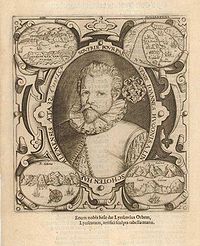Jan Huyghen van Linschoten

"His book "Itinerario: Voyage ofte schipvaert van Jan Huyghen van Linschoten naar Oost ofte Portugaels Indien" is a treasure of all the learning respecting the East and West Indies and the navigations thither... [was held] in the highest esteem for nearly a century, and was given to each ship sailing to India, as a log-book [ie., sailing manual].
Hence the many editions, which is also the cause why fine copies, especially with all the plates and maps, are so scarce.
A large part of the book is occupied by translations of original Spanish and Portuguese documents on geography, ethnography,
statistics, navigation, etc., and in these respects, it is of the highest importance and authority.
 Jan Huygen van Linschoten
(1563-1611) a
Dutchman born in Haarlem in 1563, had an "avaricious thirst for knowledge which enabled him to get detailed information of land and sea
as far afield as
the Spice Islands and China" (Penrose). Linschoten traveled to Goa in 1583 as a clerk of the newly-appointed Portuguese Archbishop of Goa. He made a few trips into India, compiling notes on his experiences, gathering information on sea routes from Portuguese sailors, and collecting data from other sources as well. Linschoten left India in 1589, hired as a pepper factor for the Fugger and Welser interests, where he learned about the organization and administration of the spice trade. Returning to his hometown, Enkhuizen, in 1592 (after a two-year stay in the Azores), he prepared his notes for the Amsterdam publisher Claeszoon in response to interest in the Netherlands and other European countries about commercial possibilities in Asia. As trade in the Far East was dependent on routes via America or Africa, his work eventually encompassed the entire globe, including Spanish and Portuguese activities in America. Linschoten's practical experience lent authenticity to his work, and it remains one of the most essential travel books of all time.
Jan Huygen van Linschoten
(1563-1611) a
Dutchman born in Haarlem in 1563, had an "avaricious thirst for knowledge which enabled him to get detailed information of land and sea
as far afield as
the Spice Islands and China" (Penrose). Linschoten traveled to Goa in 1583 as a clerk of the newly-appointed Portuguese Archbishop of Goa. He made a few trips into India, compiling notes on his experiences, gathering information on sea routes from Portuguese sailors, and collecting data from other sources as well. Linschoten left India in 1589, hired as a pepper factor for the Fugger and Welser interests, where he learned about the organization and administration of the spice trade. Returning to his hometown, Enkhuizen, in 1592 (after a two-year stay in the Azores), he prepared his notes for the Amsterdam publisher Claeszoon in response to interest in the Netherlands and other European countries about commercial possibilities in Asia. As trade in the Far East was dependent on routes via America or Africa, his work eventually encompassed the entire globe, including Spanish and Portuguese activities in America. Linschoten's practical experience lent authenticity to his work, and it remains one of the most essential travel books of all time.
 At return in Netherlands the Amsterdam publisher Cornelis Claesz, published in 1596 under the title "Itinerario: Voyage ofte schipvaert van Jan Huyghen van Linschoten naar Oost ofte Portugaels Indien … 1579-1592" his book.
At return in Netherlands the Amsterdam publisher Cornelis Claesz, published in 1596 under the title "Itinerario: Voyage ofte schipvaert van Jan Huyghen van Linschoten naar Oost ofte Portugaels Indien … 1579-1592" his book.
The Latin text edition of 1599 was followed by Dutch editions of in 1605, 1614, 1623 and 1644, and there are French editions in 1610, 1619, and 1638.
The plates in the first French edition are copies of the reduced version based on those in the De Bry. The second and third French editions return to the original, folio-sized plates of the Dutch edition.
Lach says that Linschoten's description of Goa is "one of the most original and reliable narratives prepared during the sixteenth century on life at the hub of Portugal's Eastern empire and still is regarded as one of the best sources for Goa's history at the peak of its glory.... The original edition... contains several excellent maps, three of which are of great value for the study of Asia. These maps, which are much better and more detailed than earlier printed maps, were clearly derived from the latest and best Portuguese charts of the Eastern oceans and sea coasts" - Lach.
Parry calls Linschoten's
work "a journal of human adventure and observation, an uplifting story that appeals on many levels." "Fine copies of this work with all the maps and plates are scarce" - Church catalog.
Reference works :
Alden/Landis 638/37; Tiele 686-88; Burnell & Tiele, The Voyage of John Huyghen van Linschoten to the East Indies, Hakluyt Society (Old Series) LXX-LXXI (London 1885).
Sabin (41374, the English 1598 edition, citing F. Muller, Catalogue of books on America, 1872);
Church 252; Borba de Moraes [1983], pp. 486-7;
JCB 1 (II): pp. 344-45. Rare. European Americana 596/63 & 596/64: JCB I, pp.343-345:
Shirley 192, 182; Tiele 84-87; Klooster, Dutch in the Americas, p.8 & Catalogue Item 5;
David E. Parry, The Cartography Of The East Indian Islands, p.84-85; Howgego L131;
Borba De Moraes, pp.486-487; Wagner, Northwest Coast 184; Lach, Asia In The Making Of Europe, Volume 1, pp.198-204 & 482-489.